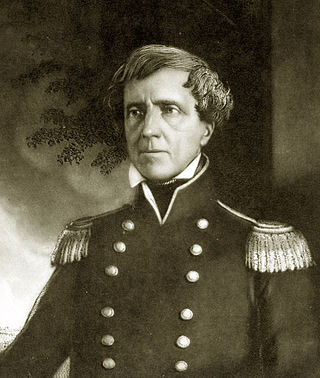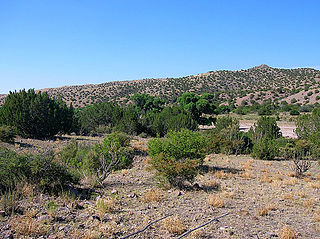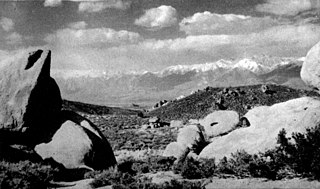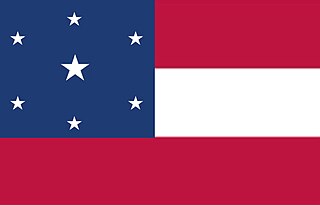
The Battle of Monterey, at Monterey, California, occurred on 7 July 1846, during the Mexican–American War. The United States captured the town unopposed.

Stephen Watts Kearny was one of the foremost antebellum frontier officers of the United States Army. He is remembered for his significant contributions in the Mexican–American War, especially the conquest of California. The Kearny Code, proclaimed on September 22, 1846, in Santa Fe, established the law and government of the newly acquired territory of New Mexico and was named after him. His nephew was Major General Philip Kearny of American Civil War fame.

Californios are Hispanic Californians, especially those descended from Spanish and Mexican settlers of the 17th through 19th centuries before California was annexed by the United States. California's Spanish-speaking community has resided there since 1683 and is made up of varying Spanish and Mexican origins, including criollos, Mestizos, Indigenous Californian peoples, and small numbers of Mulatos. Alongside the Tejanos of Texas and Neomexicanos of New Mexico and Colorado, Californios are part of the larger Spanish-American/Mexican-American/Hispano community of the United States, which has inhabited the American Southwest and the West Coast since the 16th century. Some may also identify as Chicanos, a term that came about in the 1960s.

The Battle of San Pasqual, also spelled San Pascual, was a military encounter that occurred during the Mexican–American War in what is now the San Pasqual Valley community of the city of San Diego, California. The series of military skirmishes ended with both sides claiming victory, and the victor of the battle is still debated. On December 6 and 7, 1846, General Stephen W. Kearny's US Army of the West, along with a small detachment of the California Battalion led by Archibald H. Gillespie, engaged a small contingent of Californios and their Presidial Lancers Los Galgos, led by Major Andrés Pico. After U.S. reinforcements arrived, Kearny's troops were able to reach San Diego.

The Battle of Apache Pass was fought in 1862 at Apache Pass, Arizona, in the United States, between Apache warriors and the Union volunteers of the California Column as it marched from California to capture Confederate Arizona and to reinforce New Mexico's Union army. It was one of the largest battles between the Americans and the Chiricahua during the Apache Wars.

California's involvement in the American Civil War included sending gold east to support the war effort, recruiting volunteer combat units to replace regular U.S. Army units sent east, in the area west of the Rocky Mountains, maintaining and building numerous camps and fortifications, suppressing secessionist activity and securing the New Mexico Territory against the Confederacy. The State of California did not send its units east, but many citizens traveled east and joined the Union Army there, some of whom became famous.
General José María Flores (1818–1866) was a captain in the Mexican Army and was a member of la otra banda. He was appointed Governor and Comandante Generalpro tem of Alta California from November 1846 to January 1847, and defended California against the Americans during the Mexican–American War.
The siege of Los Angeles, was a military response by armed Mexican civilians to the August 1846 occupation of the Pueblo de Los Ángeles by the United States Marines during the Mexican–American War.
The Free Company of Volunteers of Catalonia was a military company of the Spanish Army serving in the Spanish colonial empire.

Thomas Harbo Rynning was an officer in the United States Army who served with Theodore Roosevelt's Rough Riders during the Spanish–American War. He was also the captain of the Arizona Rangers, warden of Yuma Territorial Prison, and a United States Marshal in San Diego, California.

The California Battalion was formed during the Mexican–American War (1846–1848) in present-day California, United States. It was led by U.S. Army Brevet Lieutenant Colonel John C. Frémont and composed of his cartographers, scouts and hunters and the California Volunteer Militia formed after the Bear Flag Revolt. The battalion's formation was officially authorized by Commodore Robert F. Stockton, commanding officer of the U.S. Navy Pacific Squadron.

The Battle of Canada Alamosa as it was known to the Union Army, or Alamosa as it was known to the Confederates, was a skirmish of the American Civil War on the late evening of September 24 and the morning of September 25, 1861. It was one of several small battles that occurred in Confederate Arizona near the border with Union held New Mexico Territory, this one being the largest.

The 1st Battalion of Native Cavalry, California Volunteers was a cavalry battalion in the Union Army during the American Civil War. Recruits were largely drawn from the Californio population, though its ranks included Yaqui and Mission Indians as well as immigrants from Mexico, Hispano America and Europe. In addition to its ethnic makeup, the Battalion is also considered unusual for being one of the few lancer units in the United States Army.

The 7th California Infantry Regiment was an infantry regiment in the Union Army during the American Civil War. It spent its entire term of service in the western United States, attached to the Department of the Pacific, serving in California and Arizona Territory. They were unofficially known as the "Gold Diggers" in reference to the large number of recruits from the California's "Mother Lode" region. Later, they were also called the "Hungry Seventh" for the privations they suffered in Arizona, particularly at Fort Mason and took part in the Battle of Chiricahua Mountains. The Regiment included many veterans of the Mexican–American War.

The Owens Valley War was fought between 1862 and 1863 by the United States Army and American settlers against the Mono people and their Shoshone and Kawaiisu allies in the Owens Valley of California and the southwestern Nevada border region. The removal of a large number of the Owens River indigenous Californians to Fort Tejon in 1863 was considered the end of the war. Minor hostilities continued intermittently until 1867.

The Mason Henry Gang were bandits operating in Central and Southern California between 1864 and 1865. As the American Civil War was in progress, they were able to pose as Confederate Partisan Rangers, and their original mission was to rid the area of (anti-slavery) Republicans. But when it became clear that the Confederate cause was lost, they turned to outlawry, plundering and killing without mercy.
Camp Low, or San Juan Bautista Post, was a military post first established at San Juan Bautista, San Benito County, California in December 1864 by California Volunteers, in response to the attacks of the Mason Henry Gang in the surrounding area, during the American Civil War. The post was named in honor of the Governor of California Frederick F. Low.
Camp Babbitt was an American Civil War Union Army camp located in two sites in the vicinity of Visalia, California.
The Battle of Sulphur Springs involved members of the 1st California Cavalry Battalion and the Chiricahua and took place in Sulphur Springs Valley, Arizona. It was the only engagement of General John S. Mason's 1865 campaign against Apaches led by Cochise.
Tanorori's Raid occurred when a force of about 350 Opata volunteers, under the command of Colonle Refugio Tánori, attacked the ranching community of San Rafael, Arizona. The raid was an attempt to capture Sonora Governor Ignacio Pesqueira.












